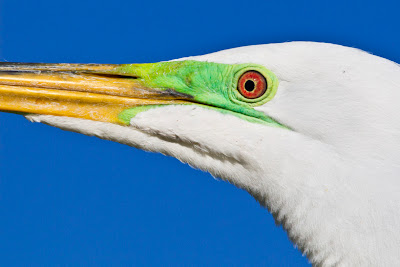I spent several mornings at Gatorland (http://www.gatorland.com/) this week. In the past Gatorland sold a photographer's pass which allowed early entry to the park before the main gates opened. This has been discontinued (it is still available at the Saint Augustine Alligator Farm) and now opens to everybody at 9 A.M. The sun is quite high already at this time and makes it difficult to photograph white herons and egrets without blowing the highlights. A hazy or overcast day with flash might allow more keepers.
Most of the visitors are there for the alligators and usually do not go away disappointed. One estimate gives 3,000 alligators and 89 crocs. It is a great place for parents and grand parents to take the kids. They are mesmerized by all the alligators and the park helps but putting on a couple cheesy but entertaining shows such as the "Gator Jumparo" and "Gator Wrestling". There is also a train ride, "budgie room" aviary, water playground, petting zoo, and rare blue-eyed white alligators. Under construction is a zipline which will allow brave souls to fly over the alligator pool.
"Famous" entry to Gatorland
Since the alligators are fed and well cared for they are pretty content
During feeding time this Great Egret seems to be taking unreasonable risks by snatching away food from the gators
Most photographers head straight for the bird rookery. During breeding season bird nests are everywhere in the vegetation while alligators lurk below. At first glance one would think that this would be the worst place in the world for birds to raise young but it works out quite well. There are many tree climbing predators which take a tremendous toll of eggs and young in rookeries. Alligators actually keep the number of predators in check and since alligators haven't learned to climb trees it works out quite well for the birds. Anything that falls out of the nest or adult birds which become too careless, however, are fair game for the alligators.
I decided to concentrate on head shots and take the occassional flight shot when it presented itself.
Snowy Egret
Tricolored Heron
Great Egret
Closeup showing the orange yellow bill and lime green lores and eye-ring of a Great Egret in breeding plumage. All of these parts will fade to a dull yellow near the end of the breeding season.
Great Egret entry for the ugliest baby contest
White Ibis in breeding plumage. The legs, bill and face are pink or flesh-colored during most of the year.









The first and foremost point of becoming a nature photographer is passion. You need to be passionate and ambitious toward natural life. You have to show your interest and confidence to achieve something big. Without self-motivation and vast knowledge, you cannot be succeeded in this competitive field. So you need to research deeply and involve yourself with the natural world.
ReplyDelete